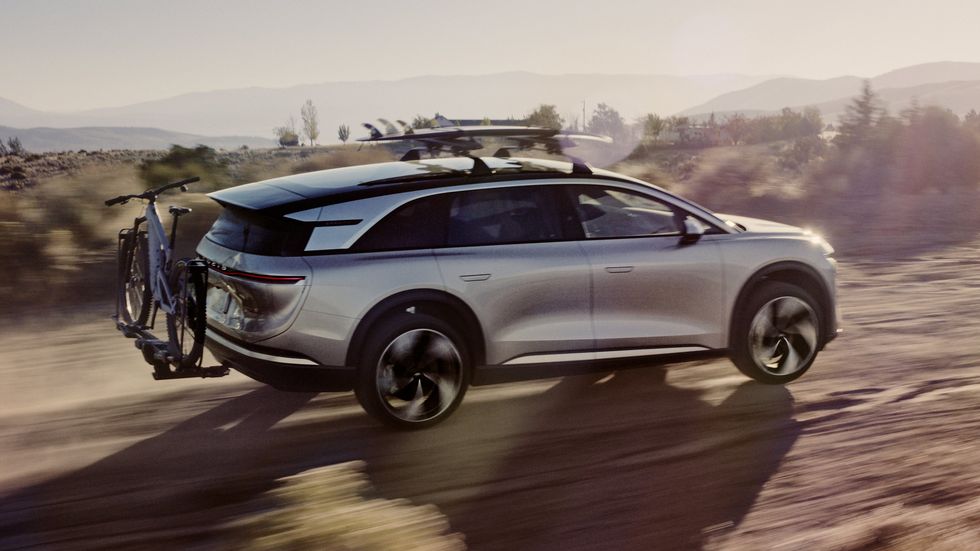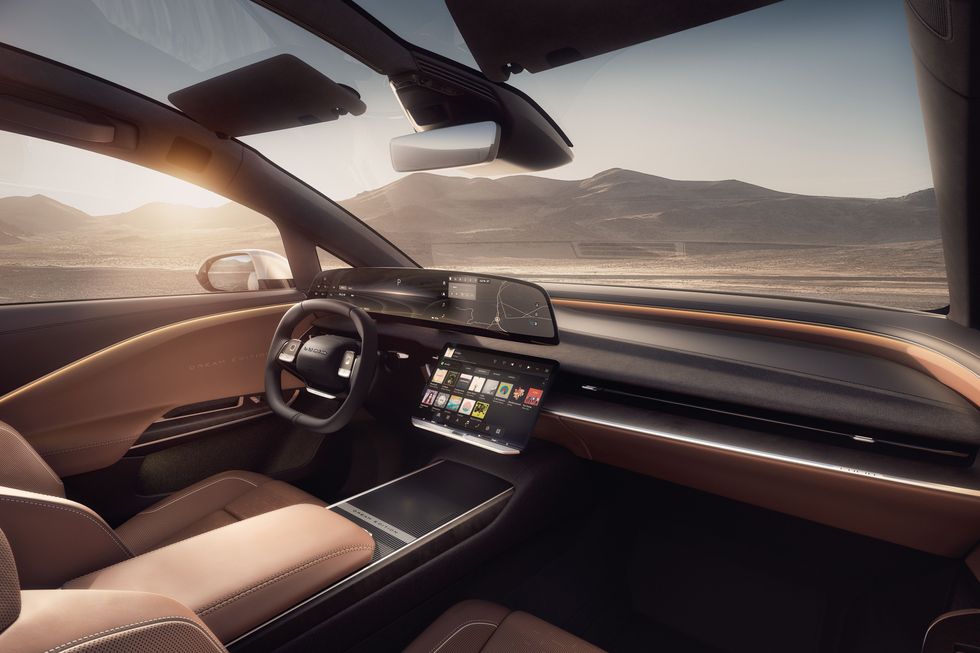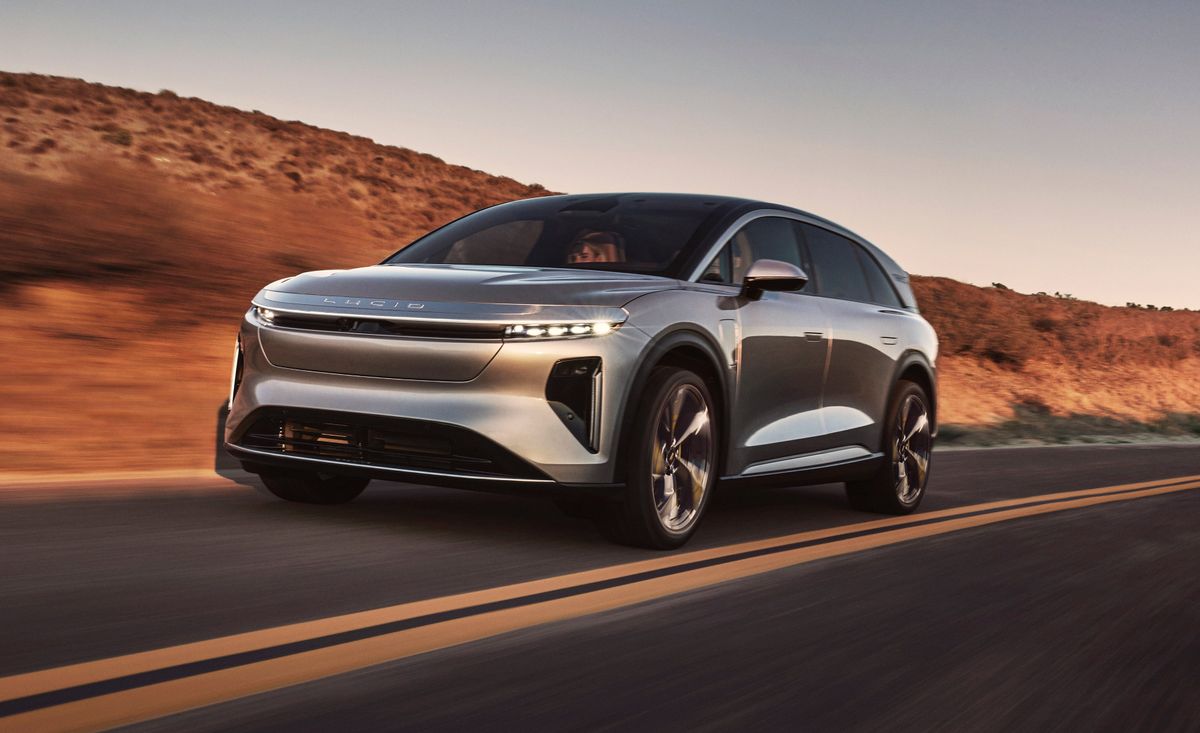The Lucid Air breezed to a world record for EV driving range, but sales of the pricey sedan have failed to soar. The California-based Lucid Motors unveiled a hoped-for savior Thursday at AutoMobility LA: The Lucid Gravity, a handsomely wrought luxury SUV with seating for up to seven passengers, and a love letter to car shoppers whose hearts have turned against sedans.
Like the Air, the Gravity will trumpet technical and performance bona fides, honed by Lucid founder and CEO Peter Rawlinson, former chief engineer of the Tesla Model S. The company estimates the Gravity will deliver a federally rated driving range of more than 708 kilometers (440 miles) in its most-efficient iteration. Using the Air’s closely related power train as a guide, we’re convinced the Gravity will whip all range records for electric SUVs, including the 560-kilometer (348 mile) stamina of a Tesla Model X Long Range.
That said, no EV company—let alone one that targets 500,000-unit annual production by 2030—can make a go of it by selling fewer than 10,000 luxury sedans a year.
Yet a burning question remains, as the Saudi-backed Lucid ransacks a multibillion-dollar war chest and watches its stock price tumble from euphoric IPO highs: Will enough people buy the Gravity to guarantee Lucid’s future, in the face of increasing headwinds for EV startups? Hurdles include a sudden slew of SUV competitors and a (potentially temporary) slackening of EV demand, spurred by inflation and rising interest rates. Lucid has burned through US $3.7 billion in cash over the past four quarters, a loss of more than $330,000 for every Air it has sold. The automaker recently cut its 2023 production forecast to 8,000–8,500 vehicles, down from 10,000.
On the glass-half-full front, Lucid may only have delivered 1,457 Airs in the third quarter. But Mercedes-Benz sold just 1,100 units of its flagship EQS sedan, the Lucid’s direct competitor, and 969 units of its more-affordable EQE sedan. Excluding Tesla’s Model S (whose own sales have dwindled), only Porsche managed to sell more high-end electric performance sedans than Lucid, with 2,050 sales for its Taycan, and that with a 55 percent boost versus the third quarter of 2022.
That said, no EV company—let alone one that targets 500,000-unit annual production by 2030—can make a go of it by selling fewer than 10,000 luxury sedans a year; at prices ranging from $77,400 (for a single-motor Air Pure) to $249,000 for the insane tri-motor, 1,243-horsepower Air Sapphire. One upside is that the Gravity seems certain to outsell the Air, simply because it’s an SUV with the height, footprint, and AWD layout that Americans (and increasingly, Europeans) favor. The Gravity appears to bring ample juice in design and tech to put the squeeze on many rivals, and make for some uncomfortable performance comparisons.
Even Tesla’s most-efficient, three-row SUV would trail the Lucid’s energy consumption by a significant 7 percent, on a per-kilometer basis.
With a canny blend of concave and convex surfaces, the Gravity’s exterior design announces its progressive intent, with a backbone of elegant understatement. A steeply raked roofline give way to a surfboard-edged roof spoiler. Derek Jenkins, Lucid’s senior vice president of design, said the company is targeting a drag coefficient of less than 0.24, which would top the Tesla Model X as the planet’s most aerodynamic SUV. A massive 227-liter (8.0-cubic-foot) storage “frunk” below the hood is a calling card, so large that two people could lounge inside the cavernous space. The Gravity will feature a standard “glass canopy” that was a bravura design element of the Air, a transparent roof that creates a virtually unbroken vista from the windshield to the rear deck. At the rear, a striking clamshell liftgate opens up a notably wide load floor for cargo.

As with the Air, outstanding interior packaging is a clear selling point, with adults well over 6 feet tall fitting comfortably in either the second or third row. That’s especially impressive in a low-slung SUV whose roof rises just 166 centimeters (65.2 inches) off the pavement. For comparison, a Rivian R1S is more than 30 cm taller (12 inches) at its maximum off-road ride height; even a boulevard-bound Mercedes EQS SUV is 6 cm (2.4 inches) taller. Rear doors swing out an unusual 90 degrees for easy ingress and egress. Stretching about 503 centimeters (198.2 inches) in length, on a generous 303-cm (119.5-inch) wheelbase, the Gravity is virtually identical in length to an Audi Q7, yet a seven-passenger Gravity should offer nearly 50 percent more total cargo space at 3,171 liters (112 cubic feet). Wheels range from 20 to 23 inches, with taller wheels and larger tires naturally dinging maximum driving range.
Inside, the Gravity looks to up the ante on the Air’s already acclaimed cabin, which combines West Coast minimalism with rich-looking materials and evident craftsmanship that’d shame anything from Elon’s penny-pinching studios. A new OLED “Clear View Cockpit” screen moves higher on the dash for easier viewing. Its alluring curved glass now enables a single display across its full 86 cm, rather than in three sections on the Air. A center “Pilot Panel” display gets a landscape orientation for better compatibility with phone and media apps, and doesn’t retract into the dashboard as in the Air. New capacitive switches on the steering wheel offer swipes and other redundant controls for the center touchscreen. It’s all managed by a new UX 3.0 system that Lucid developed in-house, and ideally works more intuitively than its current setup. A sliding cover tops an enormous configurable center console, with movable “Bentos” boxes for storage. A 22-speaker “SurrealSound” system brings Dolby Atmos to the experience, with massaging seats an option. A head-up display with laser-enabled augmented-reality features is a new option.

In Los Angeles, Rawlinson showed off a “Dream Edition” that will kick off the Gravity’s sales introduction in late 2024. That Arizona-built model will adopt a new-generation version of Lucid’s famously compact and efficient dual-motor power train, with more than 800 horsepower in Dream Edition guise. That Dream Edition should hum from 0 to 100 kilometers per hour (0 to 62 miles per hour) in 3.5 seconds or less. With its new SUV platform and sophisticated 900-volt architecture, the Gravity will accept a DC charge at rates above 300 kilowatts, replenishing up to 321 km (200 miles) of range in a class-best 15 minutes. The Gravity won’t be a rock-climber like a Rivian R1S, but a “Zero Gravity” air suspension operates over four ride heights, with a useful 2,721-kilogram (6,000-pound) towing capacity.
Lucid is still mum on many tech details, but executives said the Gravity would hew closely to the Air’s power-train choices and specifications, which currently include Grand Touring, Touring, and Pure models. Executives did say the Gravity will initially be offered only in seven-passenger, AWD form. The company is touting a starting price “below $80,000,” but that’s surely for a starter model that won’t be available until well after launch. Expect prices well above six figures for that initial Gravity Dream Edition, since the Air Dream Edition went for a stiff $169,000. As with the Air Pure—whose price was sharply cut after Tesla slashed their own prices—the sub-$80,000 claim likely describes a Gravity Pure with roughly 353 kW (480 hp) from a dual-motor power train. Lucid executives would not say whether the Gravity would eventually offer a single-motor, rear-drive model as with the Air Pure’s most-basic form.
Again hewing to the Air’s spec, the Gravity Dream Edition should feature the larger of Lucid’s two battery packs, with 118 kW spread over 22 modules. A roughly 112-kilowatt-hour battery may support some lower-priced versions. That compares with a Rivian R1S whose battery packs come in three versions: 105-kWh, 135-kWh, and the 180-kWh “Max.”
Here’s where Rawlinson’s oft-touted engineering savvy and obsession with efficiency comes in. In its most-efficient Dual Motor form (versus stronger Quad Motor models), the Rivian R1S squeezes an EPA-rated 566 km (352 miles) from a 135-kWh battery pack. But Lucid says the Gravity will travel 25 percent farther at about 708 km, despite a 13 percent smaller battery at 118 kWh. (Obviously, the Rivian’s taller profile and all-terrain, adventure-truck design are its main efficiency handicaps). A burly Quad Motor Rivian R1S is targeting about 628 km (390 miles) of range, but that’s with an enormous, optional 180-kWh “Max” pack that’s 52 percent larger than the Lucid’s. For its part, a Mercedes-Benz EQS SUV squeezes out a mediocre 491 km (305 miles) from a 108.4-kWh battery. Among direct rivals, the Model X fares best with the aforementioned 560-km (348-mile) range from a smaller 100-kWh battery. But even Tesla’s most-efficient, three-row SUV would trail the Lucid’s energy consumption by a significant 7 percent, on a per-kilometer basis.
It all adds up to a stately, streamlined, electron-sipping SUV that goes like the blazes and charges faster than any rival out there. Now all Lucid has to do is convince shoppers that, like Tesla before it, there’s no reason to dismiss an EV simply because the company is new and its name unfamiliar.
- Behind the Wheel, Under the Hood of World’s First 500-Mile EV ›
- Lucid Motors' Peter Rawlinson Talks E-Car Efficiency - IEEE Spectrum ›
Lawrence Ulrich is an award-winning auto writer and former chief auto critic at The New York Times and The Detroit Free Press.



